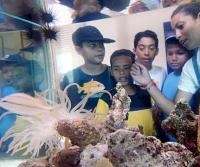Learning environmental sciences in Fajardo
Submitted on 15 July 2006 - 3:40pm
This article is reproduced by CienciaPR with permission from the original source.

By Mildred Rivera Marrero / end.mrivera1@elnuevodia.com
endi.com
The pelú crab, red mangrove plants and Pyrocistes Fusiform (that produces bioluminescence) were organisms that they knew only by reference, but onestay in las Cabezas de San Juan natural reserve allowed them to watch them closely and discover its importance for environment.
Twenty students between 9 and 12 years-old that participated in the Immersion workshop held every summer by the Puerto Rico Conservation Trust had the privilege to see different ecosystems in one week and learn about them in a fun way. The Trust has been celebrating this activity directed to public school students for 13 years, and this year they count on the support of A la Cima’s program, of the University of Puerto Rico (UPR), explained the superintendent of the Reserve, Elizabeth Padilla.
The rocky beach, the historical lighthouse, the mangrove swamp, the dry forest and the Great Lagoon - one of the three water bodies that have constant bioluminescence in the Country, are ecosystems that cohabit in the Reserve and which served as the scene for the kids’ expeditions. “I had never been in a dry forest nor a mangrove swamp, but I had studied them. I was surprised. It is a success. Here it is better than in my house”, indicated to an extroverted Kelvin Hernandez, of 10 years, while taking a stroll on the boardwalk that crosses the mangrove swamp.
In front of him, Rebeca Torres, of 11 years, commented that “everything is so pretty. (It has) so many things that I’ve seen in the books and now I see them here”. Minutes later, the group listened to the explanation of the educator, Esther Diaz, and of the leader Jennifer Walker Diaz, on the development of the seeds of red mangrove. And they observed under the leaves of white mangle, the two glands, through where the tree eliminates the salt. “We work on the conservation, the respect and the love for nature”, said Esther.
In the long walk, during which they watched the aerial roots of mangroves, from side to side, the group arrived at a clear from where you can see the Great Lagoon. There, they stopped and the leader Carla Avenancio used an apparatus to measure the depth of the water body, of which, later, they would gather a sample to see it under the microscope.
Twelve leaders work in the workshop after participating in it as students and to support the activities of the Trust. The group teaches the kids with their previous experiences and, although they work long hours, they enjoy it very much.
“For me it is not work, is an entertainment. You pass on to them what you know and you see that when they leave here they carry love for nature”, said Jennifer, of 17 years, one of the leaders. Others in her position have discovered their passion for sciences and have decided to continue college studies in that field, explained Esther.
The development of leaders is the second objective of the camping, during which the participants spend the night in the lighhouse, and they commit to do presentations on different species. They receive talks on environmental subjects, they make handcrafts, and visit other properties of the Trust like Haciendo Esperanza, in Manatí.
In order to participate, the students had to apply, write an essay and prove they have a GPA of 3.60 or higher.







